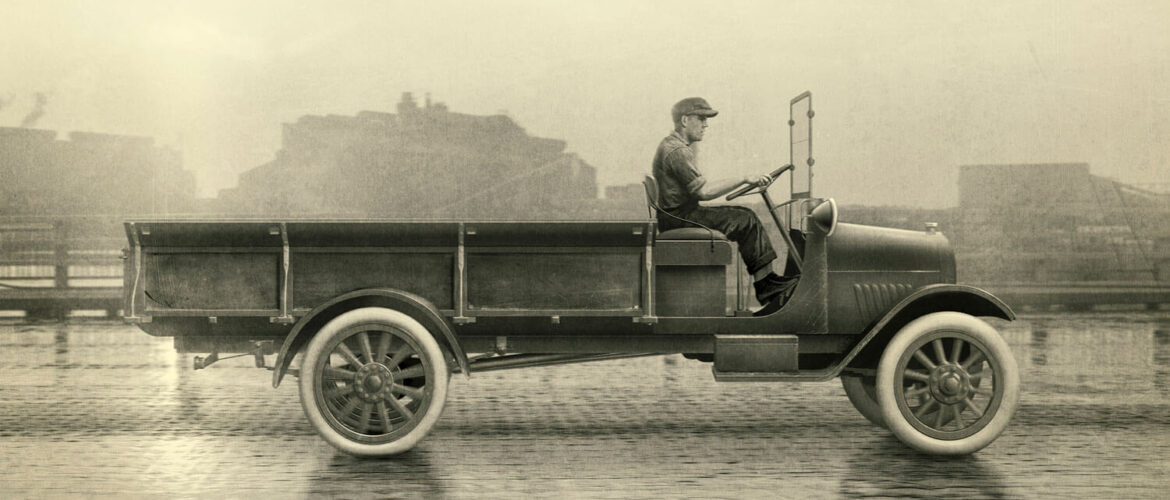The trucking industry is one of the most interesting and innovative segments of the modern economy. It’s been a logistical keystone for many decades, and has a fascinating history with both the workforce and the machinery that powers its transportation and delivery.
In the Beginning
In one sense, trucking actually predates trucks. Transporting cargo is as old as civilization, and one key sign of the age of trucking is in the name of its biggest union. The Teamsters date back to the earliest days of organized labor, and as their name indicates they were originally concerned with the drivers of teams of horses. The union came into existence years before the first Model T rolled out of Henry Ford’s factory. Due to the influence of that union, trucking has frequently occupied an important role in the history of labor and management relations. That includes collective bargaining over compensation, time, rights, and other points of interest, as well as navigating the decisions of Congress and the Supreme Court to chart out the legal precedents for future unions.
At the same time, the rapid evolution of transportation technology has driven massive changes over the entire industry. When motorized vehicles replaced horse-driven ones, it meant an enormous increase in the quantity and speed with which goods could flow from place to place. This transformed the entire economy, as the ability to rapidly deliver large quantities of anything – from fresh food to luxury clothing – dramatically altered the choices available to consumers. And in so doing, created the modern industry of trucking.
The steady march of innovation has meant the emergence of new roles for trucks. For example, the arrival of refrigeration and refrigerated trucks made it possible to keep food and drinks cool, and the development of increasingly powerful engines meant larger and more spacious trucks could take to the road for longer and more arduous journeys.
The 20th Century
The 20th century brought new competition. Trains have always played a major role in cargo. But both trains (and shipping as well) are limited by the terrain and infrastructure that can support them in a way that trucks are not. The arrival of commercial flights created a new channel for logistics that couldn’t match the capacity of trucking, but could deliver goods faster. Aviation and the midcentury expansion of the interstate highway system created and defined the role of trucks as the best and most versatile way to haul goods between major transportation nodes.
Over the same time period, the United States built itself into a dominant industrial power, and began to transition to a service economy that imported goods from overseas. This altered the routes and demand for trucking. Old industrial cities no longer needed trucks to ship out finished goods, but large ports and international airports had more goods flowing through that needed to be distributed around the country.
By the end of the 20th century and in the early 2000s, the US economy was undergoing another radical change with the introduction of the Internet and home computing. On the outside, online shopping created a whole new channel of delivery. Customers became accustomed to the idea of an ever-widening array of goods that could arrive at their door more quickly than ever before thanks to the work of truckers across the country. Within the trucking industry, computing became a crucial tool in helping to create maps and routes, automating the scheduling process, and transforming the organization of logistics itself.
Modern Times
Today trucking involves more goods, larger trucks, and highly specialized drivers and vehicles for optimized delivery to businesses and consumers. Trucking faces a variety of new challenges that are sure to drive even more change in the industry.
Hybrid & Electric Vehicles
Due to increasing awareness of global warming, trucks need to be more fuel-efficient and produce less pollution than before. This is altering the way truck engines are designed as well as what people choose to ship. When you combine this with the unpredictable price of fuel, it becomes clear that the industry is transitioning towards greater reliance on hybrid and electric vehicles. The cost of building trucks like those tends to be higher than trucks with combustion engines. And there are still plenty of kinks to work out, such as building out a charging network and ensuring reliability in design. But the move towards lower fuel consumption for all transportation is such a strong force that it is just a matter of when, not if, it arrives.
Autonomous Vehicles
Automated driving is growing in sophistication and applications but it is not yet clear when – or if – automated driving will become commonplace. However, because of its reliance on human drivers, trucking is one of the industries that will be the most affected as this technology develops. The role and definition of what a trucker is may undergo major changes as automated driving tools expand.
Unions
The history of trucking is intimately tied to organized labor, and the future of what automation means for trucking and how that will impact customers, workers, and management will be complex. Unlike with the shift towards environmental transportation, there is also a great deal of uncertainty, because there is no guarantee that there will ever be a fully automated system capable of safely driving a truck that will satisfy regulators.
The Future is Bright
While many people think of trucking as a static industry, a relic of the last century, it is actually one of the most dynamic parts of the economy. It has produced many key innovations and every major innovation in the economy has affected trucking. It has experienced constant change, and its place at the crossroads of the consumer economy, organized labor, industrial consolidation, and technological advancement means that trucking truly reflects contemporary America.
The long history of trucking shows us that if there’s one thing that’s certain, it is that the industry will adapt and transform itself to meet every challenge that comes its way.












